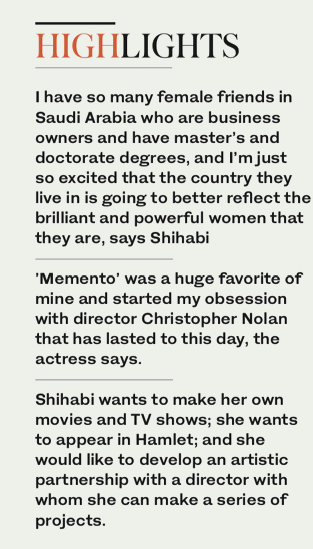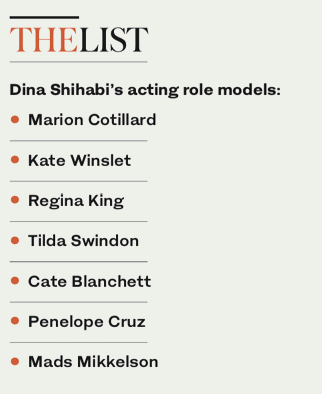JEDDAH: The 71st Annual Cannes Film Festival, which continues this week on the French Riviera, is a historic occasion for Saudi Arabia, as it marks the first time that the Kingdom has participated in the event.
The newly formed Saudi Film Council is debuting nine short films by young Saudi filmmakers, and hosting a pavilion where guests can network with fellow professionals and representatives of the Saudi film industry, and scout out prospective film locations within the Kingdom. After officially reintroducing movie theaters last month, and establishing an opera house and national orchestra, along with the now frequent staging of musical and sporting events, Saudi Arabia is in the midst of an entertainment overhaul.
But long before any of these reforms began taking place in the Kingdom, a young Saudi actress by the name of Dina Shihabi was already blazing a trail for Saudi women in cinema as she began her own film journey in the face of regional and cultural obstacles. She was motivated to pursue an acting career and persist despite the challenges she faced along the way, and is now delighted to be witnessing the incredible, rapid changes for women, and the film industry, in Saudi Arabia.
Born in Riyadh to Saudi parents of Palestinian origin, Shihabi grew up in Beirut and the UAE, and started taking dance lessons at a young age. Speaking exclusively to Arab News, she recalled her first encounter with the performing arts in Dubai.
“I was 11 years old when I took Sharmila Kamte’s street-jazz class and everything changed,” she said. “I went home that night and told my parents I was going to become a dancer. And I wasn’t good at it — I could hardly move — but I was so obsessed with it that I would practice all day and night. I’d literally practice on my chair in school. Within a year I started dancing in Sharmila’s professional company and that’s what started my journey. It opened up that possibility in my mind.”
Shihabi had her first taste of acting while attending high school in Dubai, where she frequently appeared in school plays. Her stage presence was noticed and she was encouraged to develop it further by her theater instructor, who advised her to pursue an acting career. At the age of 18, with the love of acting deep in her heart, she moved to New York City. 
“When I first auditioned for colleges to get an acting degree, I got rejected from every program I wanted,” she said. “I ended up going to a small conservatory for two years and then not getting invited back for the third year. I think about all these rejections so early on and none of it stopped me. It just made me work harder.
“I then started taking a class with an artistic director by the name of Wynn Handman, who was incredible. After studying with him for a year I got accepted to Juilliard and New York University’s graduate acting program, two of the finest acting programs in the US — far more prestigious than any acting school that I was applying to at 18.
“Rejection is a huge part of what this life is all about, and those early setbacks really helped me develop a thick skin and a strong work ethic.”
Shihabi was the first, and remains the only, Saudi woman to be accepted to both of these world-renowned acting schools. She graduated with her Master of Fine Arts in 2014 and quickly landed her first lead role in the 2014 romantic comedy film, “Amira & Sam,” in which she played Amira, an Iraqi-Muslim illegal immigrant living in a post 9/11 New York City.
Reflecting on her motivation for pursuing an acting career, a bold choice for a Saudi woman at the time, Shihabi spoke of a love of film that goes back to her childhood.
“I’ve always been a lover of movies,” she said. “I used to come home every day from school and watch one movie over and over again for a month. Everything from ‘Jurassic Park’ to ‘The Sound of Music.’ ‘Memento’ was a huge favorite of mine and started my obsession with director Christopher Nolan that has lasted to this day.
“But being an actor never came up in my mind as something possible. Growing up in Dubai, (wanting to be an actor) is not something that’s common. Then later, when I moved to New York to pursue both (dancing and acting), acting just organically won over. I feel like this life chose me. Everything happened so naturally and now I can’t imagine my life not as an actor.”
Given the rapid changes happening in Saudi society, both for women and the film industry, young Saudi women who decide to pursue an acting career may have things a little easier than Shihabi did. However, she is delighted about the sweet justice of equal rights and increased opportunities for women in the country.
“It’s so exciting,” she said. “I feel very proud of it all. I have so many female friends in Saudi Arabia who are business owners and have master’s and doctorate degrees, and I’m just so excited that the country they live in is going to better reflect the brilliant and powerful women that they are.”
This sense of shared pride is embedded in Shihabi’s identity as an Arab woman, but it was tested when she was starting out as industry professionals urged her to change her name — something many actors agree to for a variety of reasons.
“I was told to change my name because my instructors thought my Arab last name would limit my casting opportunities,” said Shihabi. “I didn’t want to. I love my true name and I’m proud of where I’m from. I grew up wishing someone who had a name like mine, and grew up where I did, was doing what I wanted to do, and so I wanted to be able to be just that.”
 By insisting on keeping her given name, Shihabi is living proof that anyone with a dream can follow their passions without giving up their cultural and family heritage.
By insisting on keeping her given name, Shihabi is living proof that anyone with a dream can follow their passions without giving up their cultural and family heritage.
This is an exciting time for children in Saudi Arabia, who will grow up with international entertainment options that were not available to previous generations. They will spend weekends at movie theaters and not have a second thought of our 35-year cinema drought.
For those children who become inspired to act as a result, Shihabi advises a steadfast approach.
“Do it. It’s a challenging but such an enriching life,” she said. “And don’t just become an actor — write and tell your stories. The world needs you. I need you.”
A versatile actress who relishes taking on a wide variety of roles, Shihabi has a particular fondness for the genre of drama.
“I love acting in dramas. I love how it feels to get sucked into a world when you’re doing a drama. There’s silence around the experience. It’s hard to explain but it feels like the character and world sinks into your skin so deeply.”
Always one to look ahead, Shihabi discusses some of her acting goals: “I’ll share the first three that come to mind: I want to make my own movies and TV shows; I want to play Hamlet; and I would like to develop an artistic partnership with a director with whom I can make a series of projects with.”
Next up for Shihabi is a notable role alongside former “The Office” star John Krasinski in “Tom Clancy’s Jack Ryan,” an Amazon-produced series that will debut on its Prime streaming service August 31.
She has also been cast in comedian Ramy Youssef’s upcoming Hulu TV show, due to premiere in 2019.



































